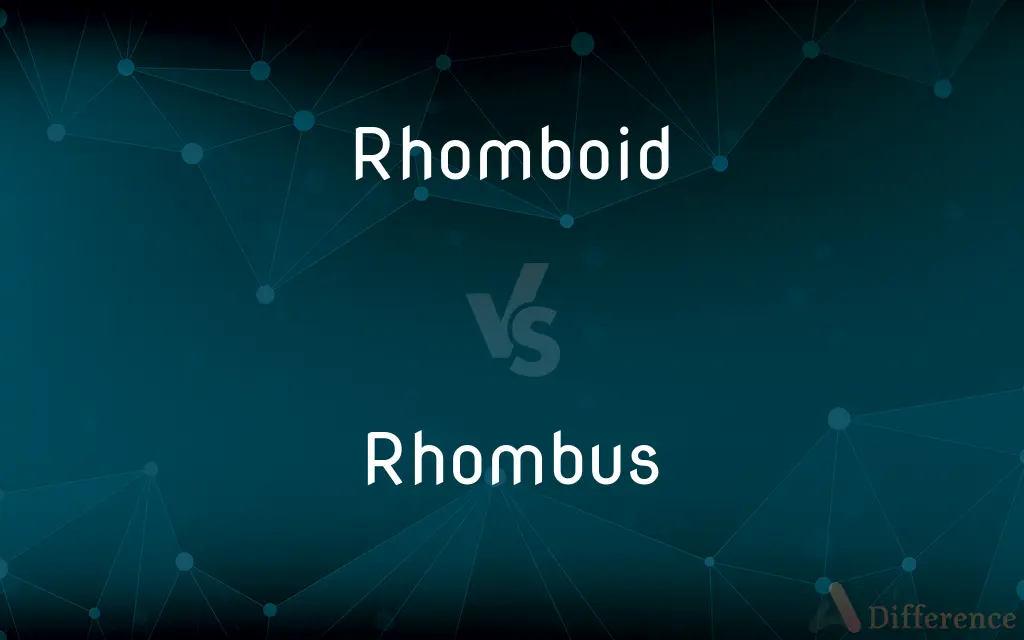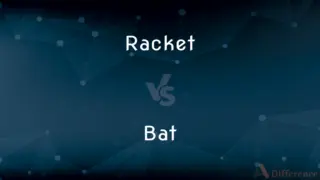Rhomboid vs. Rhombus — What's the Difference?
By Tayyaba Rehman — Updated on November 4, 2023
A rhomboid is a type of parallelogram with unequal adjacent sides and slanted angles, while a rhombus is a parallelogram with equal sides and equal opposite angles.

Difference Between Rhomboid and Rhombus
Table of Contents
ADVERTISEMENT
Key Differences
A rhomboid is a quadrilateral whose opposite sides are parallel and adjacent sides are unequal, with opposite angles that are equal. A rhombus is a special type of rhomboid where all four sides are of equal length. Therefore, all rhombuses are rhomboids, but not all rhomboids are rhombuses.
In geometry, a rhomboid is often considered a more general term than a rhombus. While a rhombus is defined by its equal-length sides and sometimes by its perpendicular diagonals, a rhomboid lacks these stricter requirements. Instead, a rhomboid simply has to have parallel opposite sides, potentially resembling a slanted rectangle.
The term rhomboid can also refer to something resembling this geometric shape in everyday language, such as a rhomboid muscle in the human body, which is shaped somewhat like a rhombus but does not have equal sides. Conversely, rhombus is typically used strictly in a mathematical context and denotes a figure with properties ideal for various geometric proofs and principles.
When considering symmetry, a rhombus has both line and rotational symmetry, while a general rhomboid has only line symmetry. This is because the equal length of a rhombus's sides gives it a more rigid form of symmetry, while a rhomboid's unequal sides do not allow for rotational symmetry.
Finally, while the internal angles of a rhombus are equal in pairs, a rhomboid may have angles that are not only oblique but are also not equal in measurement to any other angle within the shape. In this way, a rhombus's characteristics are often more constrained, making it a special case within the family of rhomboids.
ADVERTISEMENT
Comparison Chart
Side Lengths
Adjacent sides unequal.
All sides equal in length.
Angles
Opposite angles equal, angles oblique.
All angles are equal in pairs.
Diagonals
Diagonals do not bisect at right angles.
Diagonals bisect each other at right angles.
Symmetry
Only line symmetry.
Both line and rotational symmetry.
Usage
Can refer to shapes or muscles in the body.
Strictly refers to a geometric shape.
Compare with Definitions
Rhomboid
A shape resembling a slanted rectangle with opposite equal angles.
The rhomboid design on the wallpaper added a unique aesthetic to the room.
Rhombus
A diamond-shaped figure used in various geometric calculations.
The student calculated the area of the rhombus for her math assignment.
Rhomboid
A geometric figure with sides that are parallel two by two, but unequal.
The child's block was cut in the shape of a rhomboid.
Rhombus
A four-sided shape with all sides having equal length.
She decorated her book with a colorful rhombus sticker.
Rhomboid
A muscle in the upper back that resembles a rhomboid shape.
Strengthening the rhomboid muscle can improve posture.
Rhombus
A polygon that is a special case of the parallelogram.
In a rhombus, the diagonals bisect each other at right angles.
Rhomboid
Anything diamond or parallelogram-shaped but lacking equal sides or right angles.
The tiles were arranged in a rhomboid pattern.
Rhombus
A geometric shape often used in patterns and tiling.
The artist used a series of rhombuses to create a tessellation.
Rhomboid
A parallelogram with non-equal adjacent sides and angles.
The artist drew a rhomboid to create an illusion of depth in his painting.
Rhombus
In plane Euclidean geometry, a rhombus (plural rhombi or rhombuses) is a quadrilateral whose four sides all have the same length. Another name is equilateral quadrilateral, since equilateral means that all of its sides are equal in length.
Rhomboid
Traditionally, in two-dimensional geometry, a rhomboid is a parallelogram in which adjacent sides are of unequal lengths and angles are non-right angled. A parallelogram with sides of equal length (equilateral) is a rhombus but not a rhomboid.
Rhombus
A quadrilateral all of whose sides have the same length.
Rhomboid
A parallelogram with unequal adjacent sides, especially one having oblique angles.
Rhombus
An equilateral parallelogram, especially one having oblique angles. Also called rhomb.
Rhomboid
Shaped like a rhombus or rhomboid.
Rhombus
(geometry) A parallelogram having all sides of equal length.
Rhomboid
A parallelogram which is neither a rhombus nor a rectangle
Rhombus
The rhombus diamond, as one of the suits seen in a deck of playing cards (♦ or ♦).
Rhomboid
Any of several muscles that control the shoulders
Rhombus
In early Greek religion, an instrument whirled on the end of a string similar to a bullroarer.
Rhomboid
A solid shape which has rhombic faces
Rhombus
Any of several flatfishes, including the brill and turbot, once considered part of the genus Rhombus, now in Scophthalmus.
Rhomboid
Resembling, or shaped like a rhombus or rhomboid
Rhombus
Snails, now in genus Conus or family Conidae.
Rhomboid
An oblique-angled parallelogram like a rhomb, but having only the opposite sides equal, the length and with being different.
Rhombus
Same as Rhomb, 1.
Rhomboid
Same as Rhomboidal.
Rhombus
A parallelogram with four equal sides; an oblique-angled equilateral parallelogram
Rhomboid
A parallelogram with adjacent sides of unequal lengths; an oblique-angled parallelogram with only the opposite sides equal
Rhombus
A quadrilateral with opposite sides parallel and all sides equal.
The rhombus is sometimes referred to as an equilateral quadrilateral.
Rhomboid
Any of several muscles of the upper back that help move the shoulder blade
Rhomboid
Shaped like a rhombus or rhomboid;
Rhomboidal shapes
Common Curiosities
What distinguishes a rhomboid from a rhombus?
A rhomboid has unequal adjacent sides, while a rhombus has all sides equal.
What is a rhombus?
A rhombus is a quadrilateral with all four sides equal in length.
Do all parallelograms qualify as rhomboids?
Yes, since all parallelograms have opposite sides that are parallel.
What is a rhomboid?
A rhomboid is a parallelogram with opposite equal angles and sides that are parallel but not necessarily equal in length.
Is a square a rhombus?
Yes, a square is a rhombus with right angles.
Are the sides of a rhomboid all the same length?
No, a rhomboid generally has unequal adjacent sides.
Does a rhombus have rotational symmetry?
Yes, a rhombus has rotational symmetry of order 2.
What are the properties of a rhombus' diagonals?
They bisect each other at right angles.
Do rhomboids have right angles?
No, the angles in a rhomboid are typically oblique.
Is a kite a rhombus or rhomboid?
A kite can be a rhombus if all sides are equal; otherwise, it is neither.
Can a rhombus be called a rhomboid?
Yes, a rhombus is a specific type of rhomboid.
Are rhomboids used in real life?
Yes, rhomboids can refer to shapes or muscles in the human body.
Are the diagonals of a rhombus equal?
No, they are perpendicular to each other but not necessarily equal in length.
How do you calculate the area of a rhombus?
The area can be calculated as the product of its diagonals divided by two.
Can rectangles be considered rhomboids?
Yes, since rectangles have opposite sides that are parallel, they are a type of rhomboid.
Share Your Discovery

Previous Comparison
Racket vs. Bat
Next Comparison
Account vs. DescriptionAuthor Spotlight
Written by
Tayyaba RehmanTayyaba Rehman is a distinguished writer, currently serving as a primary contributor to askdifference.com. As a researcher in semantics and etymology, Tayyaba's passion for the complexity of languages and their distinctions has found a perfect home on the platform. Tayyaba delves into the intricacies of language, distinguishing between commonly confused words and phrases, thereby providing clarity for readers worldwide.















































